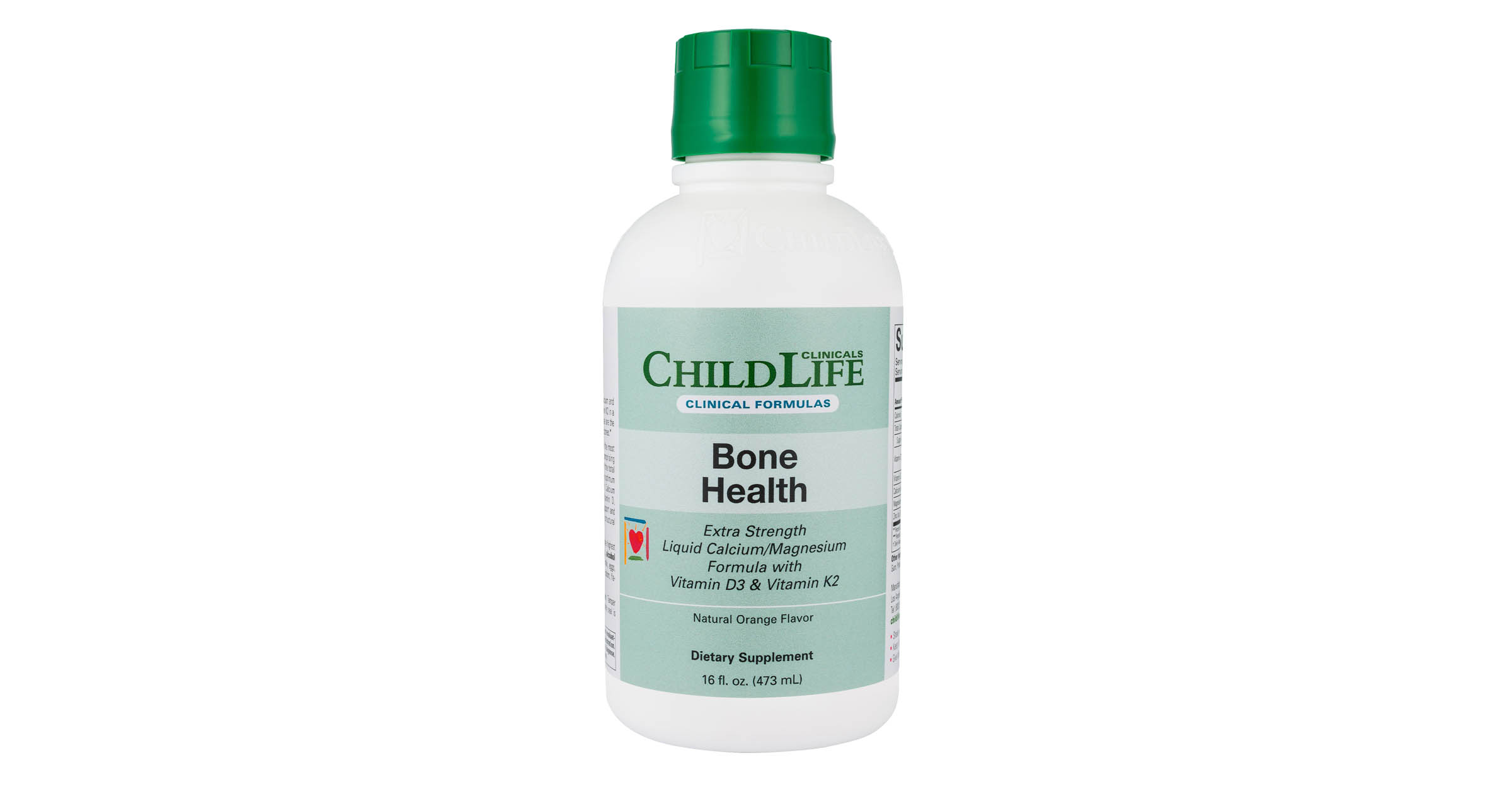Healthy Skeletal Support*
Delivers per Serving (15 mL):
- 425 mg Calcium (as Calcium Citrate)
- 120 mg Magnesium (as Magnesium Citrate)
- 3 mg Zinc (as Zinc Citrate)
- 10 mcg Vitamin D (as cholecalciferol)
- 7.5 mcg Vitamin K2 (as MenaQ7® MK-7)
Optimize Early-Life Health with ChildLife® Clinicals Bone Health.
Key Benefits*
- SUPPORTS healthy bone development
- PROVIDES superior form minerals
- DELIVERS bone-building vitamins and minerals
- INCLUDES vitamins D & K2
* These statements have not been evaluated by the Food and Drug Administration. This product is not intended to diagnose, treat, cure, or prevent any disease.
Purpose: To provide clinicians with technical information to determine if the supplement in question is appropriate for their patient.
Bone Health
ChildLife® Clinicals Bone Health contains minerals and vitamins required for healthy bone formation and maintenance.
Bone Composition & Functions
Bones are active, and are constantly being remodeled. Osteoblasts and osteoclasts are the main cells within bone which work to build and breakdown bone, respectively.
Bones are important for structural and mechanical stability of the body; however, their importance is not limited to this. Bones act as the body’s reservoir of calcium. When blood calcium levels are insufficient, osteoclasts work to release calcium from the bone matrix to maintain necessary levels of calcium in the blood.
Bone Formation in Children
Childhood is a critical period for bone growth. Ninety percent of peak bone mass occurs before adulthood.1 Children who get adequate amounts of exercise, essentials minerals and vitamins D & K, may optimize their bone mineral density.
Minerals for Bone Health
Calcium, the most abundant mineral in the body, is utilized for various functions from nerve impulses and muscle contractions to cell signaling. Since 99% of the body’s calcium resides in the bones, obtaining adequate amounts in the diet is necessary for calcium to remain abundant in bones. In terms of supplemental calcium, the form Calcium Citrate has shown better tolerability and better absorption without food, than calcium carbonate.2 Calcium Citrate is the form used in Bone Health.
In addition to calcium, magnesium is included in this formula as Magnesium Citrate. Magnesium is an essential mineral and is involved in over 300 physiological actions, including its role as a cofactor for vitamin D synthesis and use.3 Studies show an association of low magnesium intake with lower bone mineral density.4 As for trace minerals, Zinc in the form of Zinc Citrate is also included in this formula. The function of zinc in the skeletal system is that of a protective effect on bones, and support for bone integrity through suppression of osteoclast activity.5,6
Vitamin D for Bone Health
Vitamin D regulates calcium absorption in the intestines, and initiates protein synthesis for proteins that bind and transport calcium.7,8 Vitamin D deficiency, for prolonged periods leads to lower calcium absorption across the intestines and thus calcium loss from bone, leading to weakened porous bones.9 A 2001-2004 NHANES study concluded that 70% of U.S. children are either vitamin D insufficient, or deficient (<30 ng/mL 25(OH)D).10
Vitamin K for Bone Health
Osteocalcin, the protein produced by osteoblasts in bone, requires Vitamin K2 for carboxylation. There is a strong correlation between vitamin K status and bone health. Several studies in elderly women showed associations between low levels of vitamin K markers and hip fractures.11 In a study on healthy prepubertal children, levels of vitamin K markers improved significantly after supplementation with Vitamin K2, as menaquinone-7.12
A 2018 publication noted lower levels of carboxylated Osteocalcin in children with fractures.3
This formula contains the working nutrients for bone maintenance. Maintaining a healthy intake and balance of minerals and vitamins is essential to bone health.
References:
- Osteoporosis: Peak Bone Mass in Women. National Institutes of Health. https://www.bones.nih.gov/health-info/bone/osteoporosis/bone-mass. Accessed December 2019.
- Institute of Medicine (US) Committee to Review Dietary Reference Intakes for Vitamin D and Calcium; Ross AC, Taylor CL, Yaktine AL, et al., editors. Dietary Reference Intakes for Calcium and Vitamin D. Washington (DC): National Academies Press (US); 2011.
- Rosanoff A, Dai Q, Shapses SA. Essential Nutrient Interactions: Does Low or Suboptimal Magnesium Status Interact with Vitamin D and/or Calcium Status?. Adv Nutr. 2016;7(1):25–43. Published 2016 Jan 15.
- Rude RK, Singer FR, Gruber HE. Skeletal and hormonal effects of magnesium deficiency. J Am Coll Nutr 2009;28:131–41.
- Yamaguchi M. Role of nutritional zinc in the prevention of osteoporosis. Mol Cell Biochem. 2010;338(1-2):241-54.
- Florencio-Silva R, Sasso GR, Sasso-Cerri E, Simões MJ, Cerri PS. Biology of Bone Tissue: Structure, Function, and Factors That Influence Bone Cells. Biomed Res Int. 2015;2015:421746.
- Fleet JC. The role of vitamin D in the endocrinology controlling calcium homeostasis. Mol Cell Endocrinol. 2017;453:36–45.
- Van Ballegooijen AJ, Pilz S, Tomaschitz A, Grübler MR, Verheyen N. The Synergistic Interplay between Vitamins D and K for Bone and Cardiovascular Health: A Narrative Review. Int J Endocrinol. 2017;2017:7454376. doi:10.1155/2017/7454376.
- Laird E, Ward M, McSorley E, Strain JJ, Wallace J. Vitamin D and bone health: potential mechanisms. Nutrients. 2010;2(7):693–724.
- Kumar J, Muntner P, Kaskel FJ, Hailpern SM, Melamed ML. Prevalence and associations of 25-hydroxyvitamin D deficiency in US children: NHANES 2001-2004. Pediatrics. 2009;124(3):e362–e370.
- Vergnaud P, Garnero P, Meunier PJ, Bréart G, Kamihagi K, Delmas PD. Undercarboxylated osteocalcin measured with a specific immunoassay predicts hip fracture in elderly women: The EPIDOS Study. J Clin Endocrinol Metab. 1997;82:719–724.
- Van Summeren MJ, Braam LA, Lilien MR, Schurgers LJ, Kuis W, Vermeer C. The effect of menaquinone-7 (vitamin K2) supplementation on osteocalcin carboxylation in healthy prepubertal children. Br J Nutr. 2009;102:1171–1178.
- Popko J, Karpiński M, Chojnowska S, et al. Decreased Levels of Circulating Carboxylated Osteocalcin in Children with Low Energy Fractures: A Pilot Study. Nutrients. 2018;10(6):734.

